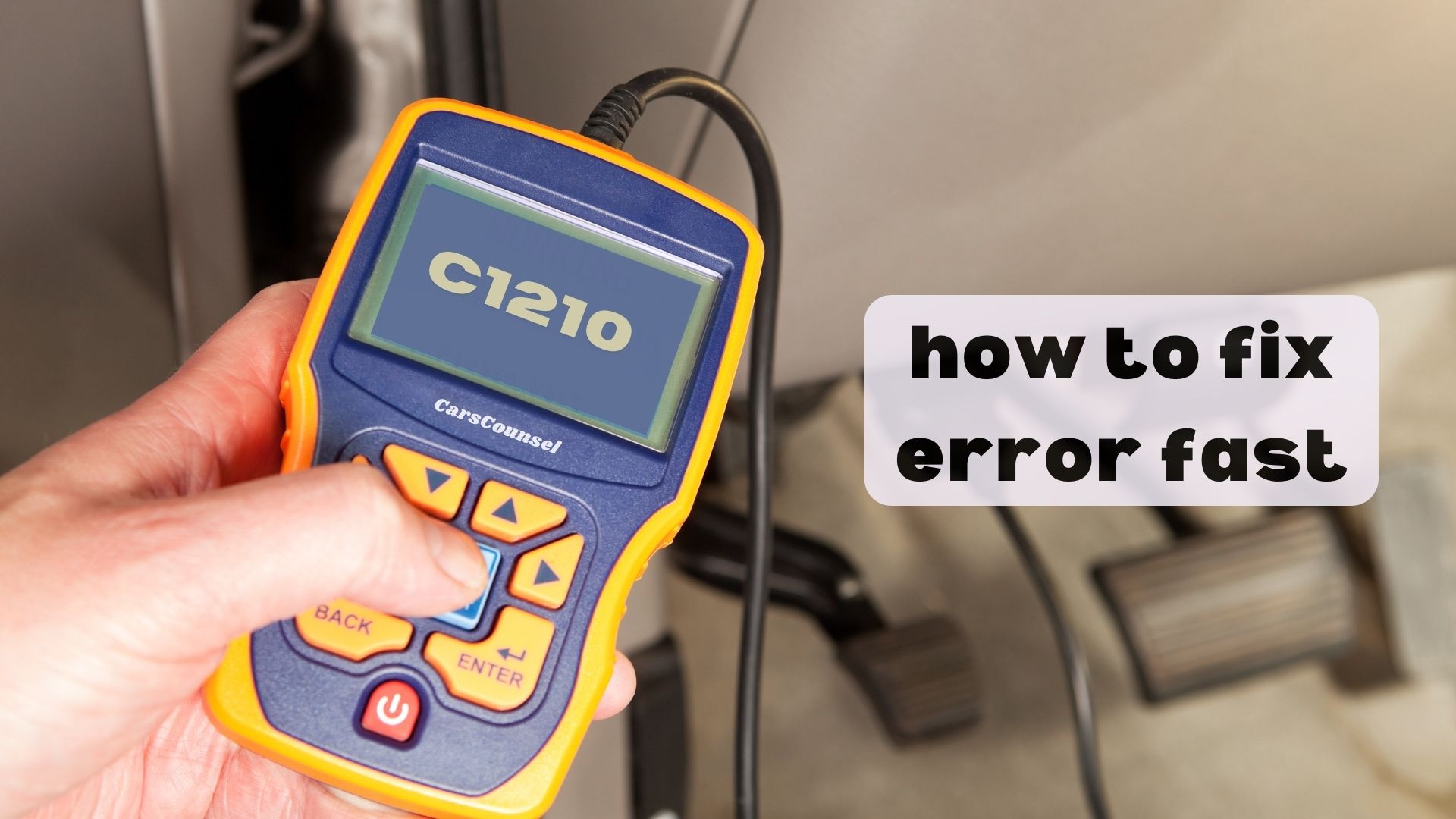Did you know that one in five vehicle crashes is caused by faulty sensors? The C1210 code is a red flag that your vehicle’s Yaw Rate Sensor, responsible for monitoring vehicle dynamics, is malfunctioning. This sensor is critical for stability and traction, and ignoring this code can lead to accidents. You’re likely wondering what’s behind this code and how to fix it. Let’s plunge into the possible causes, symptoms, and tech notes to get your vehicle back on track.

Quick Navigation
Key Takeaways
- The C1210 code indicates a problem with the Zero Point Calibration of the Yaw Rate Sensor, affecting vehicle stability and traction.
- Sensor failure, calibration issues, or faulty components like the Yaw Rate Sensor or Acceleration Sensor can trigger the C1210 code.
- Symptoms include the Anti-Lock Brake System (ABS) Warning Light, Engine Light, or Service Engine Soon Warning Light, and vehicle instability.
- Ignoring the C1210 code can lead to accidents, injuries, or fatalities, making prompt diagnosis and repair crucial.
- Proper sensor calibration and addressing underlying issues are essential to resolve the C1210 code and maintain vehicle stability and safety.
Code Meaning
Your vehicle’s onboard computer has triggered the C1210 code, indicating a problem with the Zero Point Calibration Of Yaw Rate Sensor.
This fault code suggests that your vehicle’s yaw rate sensor, responsible for monitoring vehicle dynamics, hasn’t undergone proper calibration.
The yaw rate sensor plays a critical role in maintaining vehicle stability and traction.
Sensor calibration is vital to guarantee accurate data transmission to the Skid Control ECU, which governs your vehicle’s anti-lock braking system.
Failure to calibrate the yaw rate sensor can lead to compromised vehicle dynamics, affecting overall performance and safety.
Possible Causes
The C1210 code’s indication of a calibration issue with the yaw rate sensor leads you to investigate the underlying causes.
This code is often triggered by Sensor Failure or Calibration Issues, which can be caused by various factors.
Sensor Failure or Calibration Issues often trigger this code, stemming from a variety of underlying factors.
Some possible causes to ponder:
- Sensor Failure: A faulty Yaw Rate Sensor and Acceleration Sensor (Airbag Sensor Assembly) can cause the C1210 code.
- Calibration Issues: Airbag Sensor Assembly harness is open or shorted, or there’s a poor electrical connection in the circuit.
- ECU Malfunction: A faulty Skid Control ECU (Brake Actuator Assembly) can also trigger the code.
Investigating these possible causes will help you identify the root of the problem.
How to Fix
To fix the C1210 code, start by reviewing the possible causes listed above and visually inspect the related wiring harness and connectors for any signs of damage or wear.
Check for damaged components and look for broken, bent, pushed out, or corroded connector pins.
Perform the zero point calibration of the yaw rate sensor, which may require a sensor reboot.
Fixing calibration issues will resolve the code. Address any underlying issues causing the code, such as faulty sensors or poor electrical connections.
Once you’ve fixed the root cause, the C1210 code should clear, and your vehicle’s stability control system should function properly again.
Symptoms
When the C1210 code is triggered, you may notice the Anti-Lock Brake System (ABS) Warning Light ON, accompanied by the Engine Light ON (or Service Engine Soon Warning Light).
This combination indicates a potential issue with your vehicle’s stability control system.
You may experience:
- Vehicle Instability: The C1210 code can cause your vehicle to behave erratically, making it difficult to control.
- Sensor Failure: A faulty yaw rate sensor or acceleration sensor can trigger this code, leading to incorrect data transmission to the Skid Control ECU.
- ABS Malfunction: The code may also indicate a problem with the Anti-Lock Brake System, which can affect your vehicle’s overall safety and performance.
Tech Notes
You’ll want to review the technical service bulletins (TSBs) and manufacturer’s repair information for specific guidance on diagnosing and repairing the C1210 code in your vehicle, as the procedure may vary depending on the make and model.
When addressing the C1210 code, it’s essential to guarantee proper sensor calibration to maintain vehicle stability. Incorrect calibration can lead to faulty sensor data, affecting the vehicle’s stability control system.
Additionally, consult the manufacturer’s guidelines for certifying the yaw rate sensor after replacement or repair.
Diagnostic Steps
Begin by retrieving the vehicle’s onboard diagnostics (OBD-II) trouble code data using a scan tool or code reader, focusing on the C1210 code and any accompanying codes.
Retrieve OBD-II trouble code data using a scan tool or code reader to identify the C1210 code and related issues.
This will give you a better understanding of the issue at hand.
Next, perform the following diagnostic steps:
- Sensor Troubleshooting: Check the Yaw Rate Sensor and Acceleration Sensor for any signs of malfunction or damage.
- Wiring Inspection: Inspect the Airbag Sensor Assembly harness for any opens or shorts, and check for poor electrical connections.
- System Check: Verify that the Skid Control ECU is functioning properly and that the CAN communication system is operating as expected.
Repair Solutions
To resolve the C1210 code, you’ll need to address the underlying issues causing the malfunction.
Start by checking the possible causes, such as sensor calibration issues or faulty components.
Visually inspect the related wiring harness and connectors, looking for damaged components or broken pins.
Perform the zero point calibration of the yaw rate sensor using diagnostic tools, and address any underlying issues.
If needed, replace faulty components or repair damaged wiring.
Important Safety Notes
One critical safety consideration when dealing with the C1210 code is that it’s essential to address the issue promptly, as it can affect your vehicle’s stability control system and potentially lead to accidents.
Addressing the C1210 code promptly is crucial, as it can impact your vehicle’s stability control system and lead to accidents.
Failing to do so can put you and others at risk. During a vehicle inspection, pay attention to the following safety risks:
- Loss of traction control: A faulty yaw rate sensor can lead to instability, making it difficult to control your vehicle.
- Increased stopping distance: Malfunctions in the ABS system can increase your stopping distance, putting you and others at risk.
- Accidents and injuries: Ignoring the C1210 code can lead to accidents, resulting in injuries or even fatalities.
More OBD-II Codes
| C1205 | P0332 | P1382 | P1456 |
| C1204 | C1203 | P1457 | P1491 |
| P1773 | P1783 | P1788 | P1002 |
| P1003 | P1013 | P1014 | P1015 |
| P1016 | P1018 | P1498 | P1656 |
| P1658 | P1666 | P1768 | P1668 |
Frequently Asked Questions
Can the C1210 Code Cause a Car to Fail an Emissions Test?
You’re wondering if the C1210 code can cause your car to fail an emissions test. The answer is no, as this code is related to the yaw rate sensor and ABS system, not emissions control systems, so it won’t affect test readiness or emissions failure.
Will a Faulty Yaw Rate Sensor Affect My Car’s Airbag System?
You’re likely aware that 95% of airbag failures are due to sensor malfunctions. In your case, a faulty yaw rate sensor can indeed affect your car’s airbag system, potentially leading to airbag disable, which is a serious safety concern that needs immediate attention.
Can I Clear the C1210 Code Without Fixing the Underlying Issue?
You can clear the C1210 code, but it’s not recommended without fixing the underlying issue, as it’ll likely come back. A code reset alone won’t solve the problem; consider sensor replacement or calibration to guarantee your vehicle’s stability control system functions properly.
Will the C1210 Code Trigger a Check Engine Light on My Dashboard?
You won’t necessarily see a check engine light on your dashboard indicator for the C1210 code, as it’s related to the Anti-Lock Brake System (ABS) and stability control, not an engine malfunction, so the Engine Light might not come on.
Can a Malfunctioning Yaw Rate Sensor Cause My Car to Lose Stability?
Imagine driving on a winding road, and suddenly, your car’s stability falters, like a top spinning out of control. Yes, a malfunctioning yaw rate sensor can cause your car to lose stability, affecting vehicle dynamics, which relies heavily on precise sensor calibration to maintain traction and balance.
Conclusion
As you navigate the road, your vehicle’s Yaw Rate Sensor is the trusted navigator, charting the course for stability and traction. But when the C1210 code appears, it’s like a stormy weather warning – ignore it at your own peril. Addressing the issue promptly is vital, lest you lose control of the wheel. Don’t let faulty sensors or calibration issues steer you off course; take the wheel back by diagnosing and repairing the problem, and guarantee a safe and stable journey.

